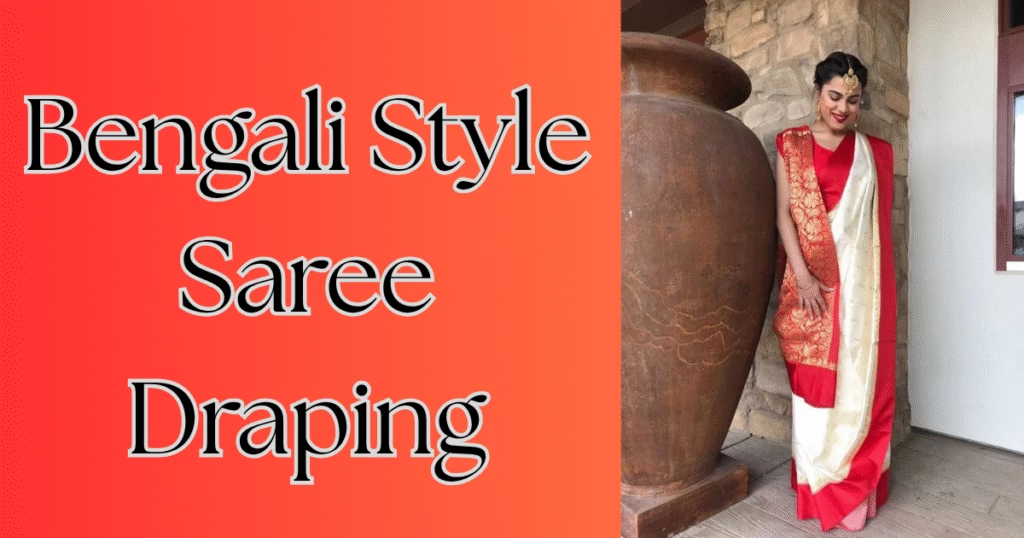Sarees are not merely six yards of cloth; they are the woven tales of culture, heritage, and grace. Bengali style saree draping is one of the most beautiful saree styles in India, as it has its own distinct structure and cultural symbolism, and it resembles a royal saree style. Traditionally worn at weddings and festivals, this style, often paired with red and white-colored shirts, has gained increasing acceptance across regions due to its elegance and uniqueness.
In case you are wondering how to drape Bengali saree traditionally, then you are in the right place. I will take you through all of that, explaining how it came about, and then walk you through an actual step-by-step process of draping, so that you can wear it with confidence and genuine confidence.

✨ Why Choose Bengali Style Saree Draping?
The Bengali saree drape is iconic. It has got wide box pleats at the front and a pallu (anchal) which is hung behind the front, over both of the shoulders. This style is frequently worn with keys or some trinket at the end of the pallu, and it is a very suited style in traditional Bengali events like Durga Puja, Bengali weddings, or cultural themed events.
It is the Bengali saree draping where how royal it displays the border and pallu beadings, making it a saree with richness and contrasting pallus.
📍 What You’ll Need:
Before we begin learning how to drape a Bengali saree, gather the following:
- A saree (cotton, silk, or tant—preferably with a bold border)
- A well-fitted blouse
- A petticoat or underskirt
- Safety pins
- Bangles or keyring for the pallu (optional)
🪷 Step-by-Step Guide: How to Drape Bengali Saree
Step 1: Tuck and Wrap
Begin on the right and insert the saree into the petticoat at your waist. Circle the saree around your waist and bring the saree again in front of you.
Step 2: Make Front Pleats
Make about 6 to 8 wide pleats forward and place them in the center of your waist. These pleats should be on the left side and fall evenly to the floor.
Step 3: Drape the Pallu Over the Left Shoulder
Take the loose end of the saree (pallu) and place it under the right arm and over the left shoulder. The pallu should not be pleated; rather, it should be wide and flat, so that the border and design are clearly visible.
Step 4: Bring the Pallu Back Over the Right Shoulder
In classic Bengali style saree draping, the pallu is folded over the head and passed under the left arm and draped over the right shoulder. This forms a circle. Pin it up and tie a key ring or decorative bunch to the edge of the pallu to give it a natural touch.
Step 5: Adjust and Accessorize
Make sure all the pins are in the right place. Keep the fall and pleats of the saree comfortable and uniform. Complete this style with traditional accessories, such as a large red bindi, white and red shell bangles called shankha-pola, and a beautiful hair bun decorated with flowers.
💡 Styling Tips for Bengali Saree Draping
- Best Sarees to Use: Go for traditional Tant, Garad, Baluchari, or cotton-silk sarees with red and white combinations for a classic Bengali look.
- Footwear: Traditional sandals or juttis enhance the ethnic touch.
- Hair & Makeup: Bold kohl-lined eyes, a red bindi, and a tied-up hair bun give you an authentic Bengali bride or festive appearance.
🎉 When to Wear Bengali Style Saree Draping
- Bengali weddings (especially for rituals like Sindoor Daan)
- Durga Puja or Lakshmi Puja celebrations
- Cultural events or themed days
- Bridal photoshoots and ethnic fashion shoots
Everyone of Bengali origin or simply someone fond of the beauty of Indian culture will, after learning to wear a Bengali saree, have an eternal, proud look.
📝 Conclusion
So it is not only fashion but also about culture and tradition, which helps in mastering the Bengali style saree draping. This style is simple, structured, and symbolic, which makes it a beautiful one. This traditional cover helps you to look elegant and serene no matter the occasion, whether it’s a wedding, festival, or cultural event.
There is just one aspect left now that you have learned how to drape Bengali saree step by step, and that is a bit of practice, and you can rock the look as the past women’s generations have done.
